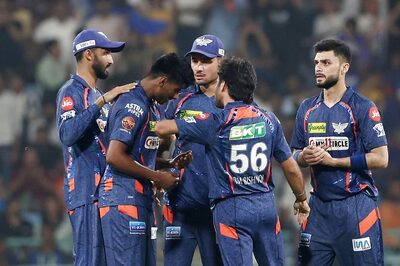
views
"Girls can be astronauts too, although I do not want to become one," said eight-year-old Manoswini with a touch of nonchalance. "I want to be a science professor when I grow up. Words like 'Jupiter' and 'solar power' give me such thrills. I had once built an entire solar system for my science project," she gushed.
A class 3 student in Patha Bhavan, Kolkata, Manoswini was among thousands of Indian children who stayed up way past their bedtime on September 7 to watch the landing of Chandrayaan-2's Vikram module on the moon. As she and her enthusiastic parents, along with the rest of India, waited for our nation create space history, television channels and OTT platforms showed live visuals of ISRO's control room, where scientists sat with rehearsed patient faces, waiting for Vikram to find its way on the moon's surface.
It was a sight India had never seen before, where, among a roomful of male faces, one could spot several women scientists on screen. It was an inspiring occasion for young girls and boys growing up in various parts of India, to learn that women are not only capable of building rockets that travel to the moon, but can also steer these rockets through cosmic voids. Moments like these give young girls real role models and young boys a fair understanding and respect for female capabilities.
Eleven years ago, however, when Chandrayaan 1 was launched, one would have needed a telescope to locate a woman in a sea of male scientists in starchy white lab coats. Things were a little different in 2016 when a viral photo of a beautiful bunch of ladies, in silk saris and flowers in hair -- who were later identified as ISRO's administrative staffers-- was mistaken for scientists behind Mangalyan. It was then that ISRO shared the details of women scientists who were actually instrumental in Mangalyan's success -- Ritu Karidhal, Nandini Harinath and Anuradha TK, among others -- and they were lauded by the media as the 'rocket women of India'.
This time, too, women scientists like project director Muthaya Vanitha, and mission director for Chandrayaan 2, Ritu Karidhal, have gathered praise for their contributions and while they both are very deserving, there are many more ISRO women who also deserve recognition. The unnamed female faces in ISRO's team, whom we watched on TV the night Vikram crash-landed on the moon and failed to communicate, also deserve considerable praise. They collectively -- along with Vanitha and Karidhal -- communicate one clear message to all Indians: Space is no longer a man's domain.
Women scientists in the team of Mission Chandrayaan 2 have shown that times are changing for the space-loving little girls who want to leave their footprints in space. The government wants to help too, which is why the Vigyan Jyoti Scheme was initiated by the Department of Science and Technology (DST) so that young girls can get mentorship from women scientists. But unfortunately, these changes are not happening nearly as fast as they should. Women still make up only about a fifth of the ISRO workforce, and that's hardly a respectable gender gap. According to a World Economic Forum report, just 14.3 per cent of science researchers in India are women and many of them will perhaps tell you that their journey hadn't been easy.
Anchal Doongarshi is one such person. The 26-year-old Mumbaikar is a mechanical engineer who builds telescopes in her spare time. When she was in school, the spacecraft failure of Kalpana Chawla left a profound impact on her, piquing her interest in aerospace. It was during the same time that she discovered the poetic brilliance of Carl Sagan. But as she pursued her higher education in science she realised that children in India, who are interested in aerospace, have very limited choices.
"There are not many institutes in India to get a degree in aerospace from. Except for a few IITs and IISC, there are hardly any educational institutions which offer such courses, and to crack the entrance exams of these colleges is very tough," said Doongarshi.
Much like other aerospace scientists in India who start their careers with a fundamental course in science (like Karidhal did by beginning with BSc in Physics), Doongarshi also enrolled in mechanical engineering only to realise that it was a male turf.
"There were four girls in mechanical engineering, including me, in a batch of almost 120 students. The general feeling was that a girl cannot be in this particular field of engineering. I just did not want to bow down to the stereotypes, the you-cannot-do-this, and the mansplaining. So I tried my best to excel." said the telescope maker.
It is perhaps the fear of this male opposition that deters many women in India from pursuing science at a higher level. While many get an undergraduate degree in science and teach the subject at school level, very few acquire a PhD or pursue a career in science. In fact, women scientists are still a 'distinct minority.'
Doongarshi's mantra for crushing this oppressiveness is this: "In a male-dominated field, the first thing you require is knowledge, the second is patience to be around male chauvinistic individuals, and of course, the skillsets that you have to develop over the years."
Children, thankfully, are yet to discover this unfairness of the world, where men and women are measured by a different yardstick. For now, most of them are busy trying to learn more about the Chandrayaan 2. In the last few days, many Mumbai kids have lined up outside Nehru Planetarium, trying to understand the workings of the celestial bodies.
"There was a point when children would say they would like to go to NASA. But now, when they visit, they tell me they would like to work at ISRO." noted Arvind Paranjpye, director of Nehru Planetarium.
"We have a laboratory in the planetarium where children come to do experiments. A few days back, a bunch of girls came to this lab to conduct science experiments from Yusuf Meher Ali school. It is a school where kids from socially deprived section go to study but when I talked to these girls, I discovered that they are very excited about the Indian space mission," added Paranjpye.
To show respect to ISRO, Nehru Planetarium has requested its visitors to scribble best wishes for the space agency on the back of their entry tickets. They have also collected message cards from various schools across India, where a group from Nehru planetarium had visited to display a demo of Chandrayaan 2. All these messages combined together will soon be handed over to ISRO.
In the meantime, kids who are visiting Nehru Planetarium are brimming with questions and Paranjpye is fielding them as efficiently as he can. "One big question, of course, is ‘what happened to Vikram?’
Explaining it right now is hard (because even ISRO is still probing and trying to understand how to establish communication). But we tell them that this project had been a 95 per cent success. They agree too," he said.
In various households across India, parents are also struggling to answer questions of their children which range from witty and ridiculous to pragmatic and interesting.
For instance, it has not escaped Manoswini's attention that photos of the moon -- with craters and dappled surface – which the television channels have been showing are very different from the ethereal orb that she sees through the leaves of the Neem tree, at her home, in Kolkata on every poornima (full moon night). Her mother had to answer a few questions about that.
She has been wondering about the moon quite a lot lately, thanks to Chandrayaan 2. "It is like a fairyland," (chand ekta roopkothar desh) she told me as she described her favorite nocturnal sky fixture with a perfect blend of poetry and myth. "It's (moon) like a cool, soft day," she added.
Another child, Mrigakhi, had been straining to connect the idea of space exploration and patriotism. This is a tough one for a nine-year-old to comprehend. The race for space dominance, the easy street cred that governments acquire whenever such audacious missions are undertaken is a difficult concept to fathom. But, Mrigakhi's mother, Parveen Sirohi, who is a teacher herself, had explained it to her in beautiful words.
"Mrigakhi is nine years old now, and I do talk to her about various things," Sirohi told News18.com. "She's fond of reading. What I try to impress upon her is that we must work on things we love...but with that, if we can combine the ideal of service -- something that benefits our fellow beings, then it becomes patriotism (both her grandfathers were in the army so she gets that). I think that what these scientists who worked on Chandrayaan 2 are doing is also something similar, it is patriotism through service. This is the definition of karma, isn't it?" she added.



















Comments
0 comment